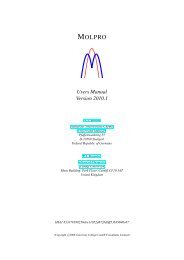CHAPTER II. POTENTIOMETRY AND REDOX TITRATIONS I ...
CHAPTER II. POTENTIOMETRY AND REDOX TITRATIONS I ...
CHAPTER II. POTENTIOMETRY AND REDOX TITRATIONS I ...
- No tags were found...
Create successful ePaper yourself
Turn your PDF publications into a flip-book with our unique Google optimized e-Paper software.
e.g., Titration of Tl + by IO − 3 in 1.00 M HCl.Titration reaction: IO − 3 + 2Tl + + 2Cl − + 6H + → ICl − 2 + 2Tl 3+ + 3H 2 OIndicator half-reaction: IO − 3 + 2Cl − + 6H + + 4e = ICl − 2 + 3H 2 O E° = 1.24 VIndicator half-reaction: Tl 3+ + 2e = Tl +E° = 0.77 VFIGURE 2-17. “Harris” Fig. 16-3 (p. 353).When the stoichiometry of the reaction is not 1:1, the curve is not symmetric. Still,negligible error is introduced if center of steepest portion is taken as end-point.Less change in voltage near equivalence point as compared to last titration curve!i.e., clearest results are achieved with strongest oxidizing and reducing agents.ii/. Redox IndicatorsA redox indicator changes color when it goes from its oxidized to its reduced state.TABLE 2-18. “Harris” Table 16-2 (p. 355).To predict the potential range over which the indicator color will change, write aNernst equation for the indicator.In(oxidized) + ne = In(reduced)E = E° − (0.0592/n)⋅log{[In(reduced)]/[In(oxidized)]}The color of In(reduced) will be observed when[In(reduced)]/[In(oxidized)] ≥ 10/1and the color of In(oxidized) will be observed when[In(reduced)]/[In(oxidized)] ≤ 1/10i.e., The color change will occur over the rangeE = (E° ± 0.0592/n) Ve.g., ferroin, E° = 1.147 VFIGURE 2-19. “Harris” (p. 354).The color change is expected to occur in the approximate range 1.088 V to 1.206 Vwith respect to standard hydrogen electrode.7











![Hetero [6+3] Cycloaddition of Fulvenes with N-Alkylidene Glycine ...](https://img.yumpu.com/35423358/1/190x245/hetero-6-3-cycloaddition-of-fulvenes-with-n-alkylidene-glycine-.jpg?quality=85)




